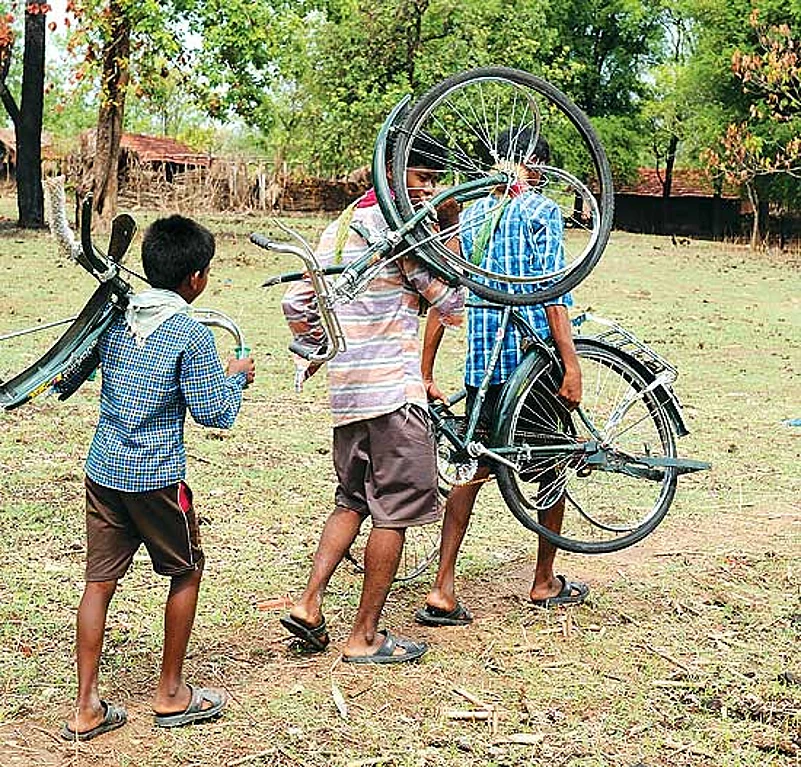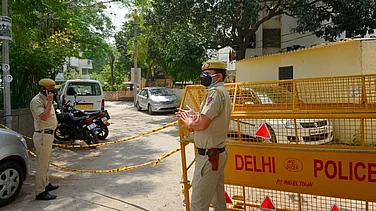The government’s current arterial push through the heart of the Maoist insurgency is a road being built diagonally across Sukma district in south Chhattisgarh. It is only when blood was spilled during the road’s construction—26 paramilitary personnel were killed on April 24 in a Maoist ambush on a CRPF detachment providing protection—that national attention shifted once again, albeit for a short while, to counter-insurgency and development in the forests of Bastar. To Maoists—going by interviews of top leaders and their statements quoted in media reports over the past few years—the region is a battleground where two ‘systems’ are locked in a life-and-death conflict. Much of local adivasi life has come to revolve around the consequent violence as the government tries to regain administrative control of tracts where the Maoists are dominant, besides aiming to put down the insurgency for good.
In fact, the conflict has divided the mostly Gondi-speaking adivasis into two camps pitted against each other: those who are part of village-level committees and militias, which the Maoist party has been organising in their areas of influence since the mid-1980s; and those working for the District Reserve Guard (DRG), which recruits locals, mostly former Maoists and SPOs (“special police officers”, formerly members of Salwa Judum, an anti-Maoist militia allegedly armed by the police and later outlawed by the Supreme Court), and forms the local component of the counter-insurgency spearheaded by central paramilitary forces. To the Maoists, adivasis are forever suspect as potential police informers, while to the security forces, any local without a uniform could be a Maoist courier or sympathiser.
“The central government should review why they have stationed us here because the villagers don’t seem to want development,” says a CRPF officer from the 74 Battalion stationed at Burkapal, who lost 26 colleagues in the April 24 ambush. No wonder villagers using the bus service between Dornapal and Jagargunda—recently restored after more than a decade—are viewed with extreme suspicion. The service had been stopped as the security forces found it risky after an incident where Maoist guerrillas boarded a bus near Basaguda in neighbouring Bijapur district, took it over and drove it straight into a paramilitary camp, spraying bullets at the jawans. Despite the inconvenience caused by the air of suspicion around them, villagers prefer to take the bus rather than settle for a 25-km ride on the back of pickup trucks by shelling out Rs 50 per head. The alternative is a walk of several hours. “The bus ticket is cheaper and there is also the bonus of not being exposed to the sun or rain like on a truck,” says Lakka, a Gond adivasi who drives a pickup truck on the same route.
Several paramilitary camps dot the Dornapal-Jagargunda stretch of the road. Most personnel do not venture out, except for planned operations. Weary adivasi passengers alight from vehicles near one such camp, some distance away from a sentry sweating behind sandbags with an SLR pointed towards the road and only a tin roof to protect him from the merciless sun. Villagers are often stopped at such checkpoints as intelligence reports had suggested involvement of locals in the April 24 ambush. Most of those prevented from going ahead are the ones without Aadhaar cards—now the standard proof of identity in these parts. “Who are you? What are you going to report?” the sentry asks this correspondent. “You must tell us.”
A similar story plays out on the road being constructed between Injira and Bhejji, where 13 CRPF jawans were killed in a Maoist ambush in March.
At Chintalnar village, Outlook meets a Bengali-speaking shopkeeper, belonging to one of the refugee families from Bangladesh settled here around the 1971 Indo-Pakistan war. He pushes his children forward and says, “I want them to study. Can you help restore electricity here? The power supply was disconnected during the peak of the Salwa Judum activities.” There are many migrants from other states who run shops and other businesses here. Around 25 km away, deeper into the forests surrounding Chintalnar village, guerrilla commander Malina tells Outlook that her party, the CPI (Maoist), too wants electricity in the remote villages, but not the roads being built, “which would be used to increase the militarisation of Bastar”.
Opposite the Chintalnar police station, a forest road curves westward towards Timmapuram village—a stretch where the police appear only sporadically. In 2011, 56 huts were razed here during an encounter between the security forces and Maoists. The forces accused Maoists of using villagers as human shields to escape into the forest and burning the huts as a distraction, but were themselves accused of setting the huts on fire in a chargesheet the CBI filed this year. Since the incident, some locals say they have got utensils and Rs 20,000 as compensation from the administration, though rebuilding each house, they point out, cost them around Rs 50,000.

The rice-hulling and oil-pressing mill built by villagers in Raiguda, burnt down during an anti-Maoist operation.
Meanwhile, some villagers sent their children to relatives in other villages or towns to study. Some of them are back for the tendu-leaf collection season, when an extra pair of hands means a few thousand rupees more for the family. At the current rate of Rs 2.12 per bundle of 50 leaves, families with five or more members are able to make up to Rs 10,000, of which around Rs 200 is allegedly “contributed” to the Maoists.
Somali, a Class 9 student in Dantewada town, looks forward to coming home to Timmapuram whenever she can. The day-long travel costs Rs 200; a fully functional road all the way to Bijapur would save her both time and money. The sick, too, would benefit. Now they have to be carried on a cot to primary health care centres in bigger villages such as Chintalnar, which are also the last stops for the much-touted one-rupee-a-kilo rice scheme. As most men from the more remote hamlets avoid being seen in Chintalnar for fear of being detained by the police, the women trek through the forest—sometimes 12 km or more—to buy rice and carry it back in sacks balanced on their heads. A portion is set aside for the Maoists, say villagers. There used to be a market in Timmapuram, but it was closed down as both Maoists and the police suspected it would facilitate the other side in gathering intelligence.
Around 3 km away is Pedda Bodkel village, where locals were allegedly assaulted on May 14-15 during a joint operation by the CRPF, the state police and the DRG. Villagers tell Outlook that the forces also burned down a rice-hulling and oil-pressing mill and several bicycles. According to the FIR filed by the police, all this was done by the Maoists.
On May 14, an elderly man was woken up by the sound of boots in the courtyard of his house in Pedda Bodkel. The one-armed adivasi had just propped himself up using his staff when security personnel barged in and kicked it away, making him fall on his back. “The other sarkar has come,” he recalls thinking. “I couldn’t make out what they were asking me.” Another villager was dragged out of his hut and asked about members of the Maoist village committees that comprise the jantana sarkar—the parallel “people’s government” set up by the Maoists. “The policemen, who spoke Gondi, made him wear a green cap and took photos with their mobile phones,” says a villager. “Every time he took it off, they beat him and put it back.”
Vimal Nuppo, who had just finished his high school and was at home for the tendu season, “woke up to the sound of shouts in Hindi”. “I could see them dragging my relatives towards the forest,” he says. The police went through his bags and asked why he had books and pens. When he produced an Aadhaar card, they said it was fake. “With an education, he will become a powerful Maoist leader,” he recalls the policemen discussing. He was left alone after someone pointed out he studied in a government school and would “join the mainstream”.
Villagers allege the police asked them to show their most prized asset, the rice-hulling and oil-pressing mill, and then burned it down. To spare themselves the trouble of a 60-km trip on bicycles across the Telangana border to hull their rice, people from a few villages had pooled their resources to buy a small machine and power generator to set it up. Three villagers confirm the jantana sarkar used to take half the proceeds from the mill. The police action against Maoists hit the villagers hard.

Bicycles used to transport rice were damaged during an anti-Maoist operation
After Pedda Bodkel, the forces moved on to Raiguda village. Most villagers were away collecting tendu leaves. Mandavi Narsa, one of the few women who had stayed back, saw the police through her hut’s bamboo wall. She alleges they came into her hut, rifled through her meagre possessions and took away Rs 5,500 she had saved. Villagers see this round of violence as a violation of an undeclared “ceasefire” that both sides observe during the tendu season. “They slaughtered the livestock, cooked and ate here, and then set fire to some houses,” she says, standing outside a hut recently constructed next to the ruins of the bigger hut that had been burnt down. Burnt rice was strewn across what had once been the floor. Villagers count 16 huts, 11 bicycles and two tractors as lost to the fire. They had bought the tractors by pooling in contributions and used them for rice cultivation.
Narsa’s story opens the floodgates for the other women, all raging against the security forces. They describe how the security forces manhandled a heavily pregnant Mandavi Ude. “A villager who left this village and joined the police (DRG) brought the forces here that day, and among them was a former divisional committee secretary of the Maoists,” says a woman. “He used to come with gun-toting Maoists; this time he came with gun-toting policemen,” quips another.

Security forces on a combing drill walk past adivasi homes in a village near Dornapal
D.M. Awasthi, special DGP (anti-Naxal operations), confirms the operation was conducted, but denies the forces burnt huts and damaged villagers’ property, citing the FIR in which Maoists have been accused of setting fire to the huts. The FIR was filed by the DRG man from Raiguda, who also alleged that “Maoist commanders Hidma, Malina and others” had threatened his family and burnt his hut.
In Raiguda, the women point to a hut that had been spared during the operation and say it was the policeman’s. Then a man in a crisp white shirt and lungi appears with three boys. The women, who had been talking animatedly, fall silent. The man is introduced as a functionary of the jantana sarkar and speaks of several other similar incidents in the area. He reveals that units of the “Maoist army”—the People’s Liberation Guerrilla Army (PLGA)—were close at hand because of a wedding ceremony in a neighbouring village. “Recently, the police detained a wedding party returning with the bride to their village. They were kept in the Chintagufa police station and accused of being involved in the April 24 attack,” he says.
Among those arrested following the April 24 ambush and accused of being PLGA members is former Chintagufa sarpanch Panda Podiam, a CPI member. Panda used to negotiate between the administration and villagers on allowing development works. His wife has since replaced him as sarpanch. In a region where Maoists killed a sarpanch accused of being a police informer earlier this year, the “respect” the former Chintagufa sarpanch commands makes him suspect in police eyes—as well as a prized repository of information about Maoists.

CRPF men on motorbikes during a routine patrol in Chintalnar
Villagers say Panda was picked up from a village, but the police claim he surrendered. His wife had filed a habeas corpus petition in the Chhattisgarh High Court, where he later appeared and said he wanted to go with the police. According to Sukma SP Abhishek Meena, “Panda was associated with the Maoists earlier too, though not actively. And on April 24, they gave him an SLR with eight rounds, of which he fired three during the attack. He told us all this.”
At a press conference, Meena claimed Panda had helped set up meetings with Maoists for journalists, activists and scholars, including Delhi University sociology professor Nandini Sundar. “We are not alleging that Sundar is conspiring with the Maoists. There are taped conversations of Maoist ideologue Varavara Rao speaking with senior Maoist leaders, but as long as he is not conspiring in unlawful activities, we can’t do anything to him,” says Meena. Awasthi agreed to let Outlook meet Panda but, in Sukma, Meena evaded it on various pretexts.
Panda had gone underground in 2010 after he was accused of helping Maoists in the ambush that killed 76 CRPF personnel quite close to where the April 24 attack took place this year. The local police were aware that he often returned home to Chintagufa. On mentioning this at the Chintagufa police station, a policeman smiles and repeats what Meena had said—“Panda had fired three rounds from an SLR on April 24”—and then recalls an incident of a few years ago. “When the Maoists had abducted seven policemen, Panda had argued with the Maoists until they were freed,” he says. Also, when the Maoists abducted Alex Paul Menon, the then Sukma collector, Panda had mediated between the state’s interlocutors and the Maoists and was present during the negotiations.
Text: Ushinor Majumdar in Bastar; Photographs: Tribhuvan Tiwari


























